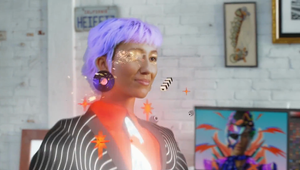
5 Minutes with… Chloé Depiesse

Adobe Firefly is a proud supporter of LBB. As part of the sponsorship of the ‘5 Minutes with…’ channel, we spend time with some of the most innovative and creative minds in the industry.
Today, we speak with Chloé Depiesse, EVP and head of digital strategy at Havas NOW. Throughout her career, Chloé has made a habit of connecting brands with people via technology in a way that accentuates humanity. Today, she’s grappling with emerging tech like AI in the context of healthcare to find ways to break down stigmas and improve lives.
In this conversation, Chloé reflects on why it’s so important for brands to keep their feet on the ground, and how the industry can do a better job of ensuring that technology is used for the betterment of humanity, rebuilding trust in the process…
LBB> Chloé - when you’re helping brands to innovate, how do you ensure that you’re addressing genuine unmet human needs?
Chloé> Our mission at Havas NOW (Havas Innovation Lab) is to leverage creativity and technology to improve people’s lives. We constantly challenge ourselves, and our clients, to think beyond brands’ problems – which are rarely top-of-mind for consumers.
According to our Meaningful Brands report, “75% of brands could disappear overnight and most people wouldn’t care.” This staggering statistic motivates us to always identify unmet human needs, and we typically do this through extensive research and empathy mapping. We also work closely with customers, soliciting their input throughout our iterative design process. This allows us to fine-tune our thinking based on real-world feedback and ensure we have effectively addressed users’ needs.
LBB> You’ve been head of digital strategy at Havas NOW for just over four years. How have things shifted in that time, and what kind of trends are you talking about today that you weren’t talking about four years ago?
Chloé> A few years ago, the Metaverse was everyone’s favourite buzzword. In my former role at Havas NY, we placed the first-ever ad in the blockchain (technically we embedded it through a series of transactions). It was considered the “nerdiest ad campaign of the year,” according to the WSJ, and was awarded two Cannes Lions.
Today of course, it’s all about AI. At Havas NOW we are firm believers in the power of this nascent technology. It has been a game-changer for our work. AI has enabled us to create products, services, and experiences that would never have been possible in a recent past. From virtual influencers to AI-powered storytelling, this technology has truly supercharged our creativity.
Perhaps less of a trend, but another new area of excitement for me has been the meteoric rise and adoption of the GLP-1 agonists [like Ozempic]; a class of drugs first used to treat diabetes that are now being adopted for weight loss. The impact of GLP-1s goes beyond healthcare, and could have massive long-term effects across multiple categories such as food and beverage, tech, and lifestyle. It is projected that 9% of the US population will take GLP-1s by 2035. Anticipating this revolution, we recently launched a GLP-1 consultancy at Havas to help our clients navigate this promising new landscape.
LBB> It’s been said that technology in modern culture is fueling a loneliness epidemic. What’s your take on that debate, and have you seen any ways in which tech is bringing people together?
Chloé> I am very mindful of the isolation and potential mental health challenges that technology, particularly social media, can fuel. However, I also see technology as an incredible tool to bring people together. At Havas NOW, we demonstrate this every day in our work.
For example, research has shown that children who suffer from cancer and are hospitalised often experience anxiety and loneliness. This also applies to children who stay at home and feel their siblings’ absence. To help address this traumatic situation, the NOW team created an interactive attachment doll called ‘Pachucho’ that connects to its twin doll, and transmits hugs from the sibling at the hospital to the sibling at home.
LBB> More broadly, do you think that the way we incorporate technology into our work is sufficiently human?
Chloé> As an industry, I think we need to do a better job of ensuring technology is used responsibly and with humanity’s best interests in mind. This requires a series of concerted efforts across governing bodies to keep up with the speed of technology. With the advancement of AI, the need for governance and ethical use of technology is more important than ever.
Havas NOW was created with one mission in mind: improving people’s lives. Everything we create in our lab puts people first and we are striving to advance humanity, one innovation at a time.
We avoid using technology simply for the sake of using technology. We leverage technology when it adds value to the final product, or helps achieve a specific, human-centric purpose.
LBB> Are there any recent projects Havas NOW has been part of that you’re especially proud of? If so, which?
Chloé> Absolutely! We recently created an award-winning Virtual Reality experience for ViiV Healthcare (a leader in HIV medicines) called ‘Chapters of Stigma’. This experience put physicians in the shoes of people living with HIV, and allowed them to experience first-hand the stigma that HIV patients still face today: humiliation, rejection, mistreatment, and fear of disclosure. After going through this experience, physicians acknowledged that stigma should be addressed with the same level of importance as the clinical diagnosis.
The experience was so successful that we took stigma-busting to a new level and launched LUUK, referencing ‘U = U’, which stands for ‘Undetectable = Untransmittable’. This terminology is often used in the HIV world to reflect that if you have an undetectable viral load, you cannot sexually transmit it. LUUK is the first-ever AI-generated virtual influencer with HIV. He shares his experiences, challenges, and triumphs with the community and is the perfect brand spokesperson to help end the HIV epidemic. LUUK debuted at the AIDS 2024 conference last month via a life-size holographic display. These two projects are great examples of cleverly leveraging creativity and technology to shift mindsets and drive behaviour changes.
LBB> We’re speaking at a time when the industry’s favourite buzzword seems to be ‘AI’. To what extent are you using AI in your day-to-day work, and does the technology leave you feeling broadly excited or broadly fearful for the future?
Chloé> My team and I have been using AI in our day-to-day work for quite some time now. From insights gathering and creative ideation, to production, we use a variety of AI tools at different stages of our process to supercharge our thinking. Perplexity AI, Globe Explorer, or Idea Ape, for example, are fantastic tools for landscape learning or audience analysis, saving hours of traditional research.
AI has enabled us to create synthetic user personas and even conduct virtual user interviews with nuanced answers mirroring real-life user feedback! We also use gen AI-powered tools like Adobe Firefly to quickly illustrate concepts, and more recently have even begun utilising them for public-facing client work.
LBB> According to a YouGov poll from earlier this year, 42% of Americans said they believed AI would have a ‘negative impact’ on society (compared to 27% who believe it will be positive). Why do you think that is?
Chloé> AI only really became mainstream in 2023, following Open AI’s Chat GPT launch in Nov 2022. As with most new technologies, there’s a human tendency to err on the side of caution, if not outright scepticism at first.
It will take time, education, and ultimately, a great deal of curiosity for people to fully adopt AI and change its negative perception. I’m confident however that AI will evolve from being seen as something to fear into a well-established technology with clear benefits.
LBB> Finally, imagine we had this conversation again in one year’s time. What do you think we would be talking about?
Chloé> I hope we see a shift from discussing the need for the adoption of technologies like AI and GLP-1s, to reflecting on the positive impact and societal change that their large-scale implementation has brought forth.















